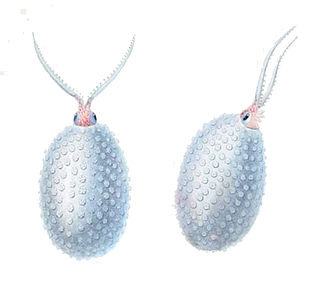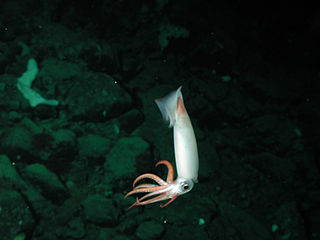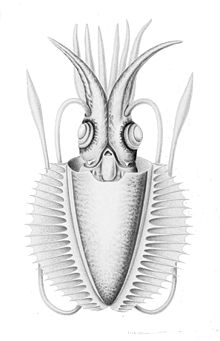
Bioluminescence is the production and emission of light by living organisms. It is a form of chemiluminescence. Bioluminescence occurs widely in marine vertebrates and invertebrates, as well as in some fungi, microorganisms including some bioluminescent bacteria, and terrestrial arthropods such as fireflies. In some animals, the light is bacteriogenic, produced by symbiotic bacteria such as those from the genus Vibrio; in others, it is autogenic, produced by the animals themselves.

The Squaliformes are an order of sharks that includes about 126 species in seven families.

Bathyteuthis is the singular genus of squid in the family Bathyteuthidae, encompassing three species.
Batoteuthis skolops, the bush-club squid, is the single rare species in genus Batoteuthis, which is the only genus in family Batoteuthidae. The squid is found in Antarctic waters, and reaches a mantle length of at least 350 mm (14 in). Some features of this creature are a small head, a long tail and a very peculiar tentacle, with six series of suckers on the club.

Histioteuthis is a genus of squid in the family Histioteuthidae. It goes by the common name cock-eyed squid, because in all species the right eye is normal-sized, round, blue and sunken; whereas the left eye is at least twice the diameter of the right eye, tubular, yellow-green, faces upward, and bulges out of the head.

The firefly squid, also commonly known as the sparkling enope squid or hotaru-ika in Japan, is a species of squid in the family Enoploteuthidae. W. scintillans is the sole species in the monotypic genus Watasenia.

Helicocranchia is a genus of small glass squids from the family Cranchiidae, known as piglet squid. They are characterized by possessing a very large funnel and in having a pair of small paddle-like fins which are attached to a part of the gladius which sits above the muscular mantle. These squid undergo a slow descent starting near the surface as paralarvae moving down to lower mesopelagic depths as near-adults.

Galiteuthis is a genus of glass squids from the family Cranchiidae and the subfamily Taoniinae. Squids in the genus Galiteuthis are large squids with mantle lengths measuring up to 660 mm (26 in), although it has been suggested that mantle length could reach as much as 2.7 m. The most distinctive feature of the speciesa in this genus are they have hooks on the tentacular clubs while there are no hooks on the arms, and by their long, thin, terminal fins.
Egea inermis is a species of glass squid in the monotypic genus Egea.

Teuthowenia is a genus of glass squid in the subfamily Taoniinae. Members of this genus are characterized by their deep-sea habitat, clear bodies, and ability to engorge themselves with water to become larger when threatened. Each known species has a visible digestive gland, which serves a similar purpose as a stomach and liver.

Cranchia scabra is a species of glass squid. It is the only species in the genus, and is fairly small. The mantle is covered by large, multi-pointed cartilagenous tubercles. When disturbed, the squid often pulls its head and arms into the mantle cavity and folds its fins tightly against the mantle to form a turgid ball. The tubercules, presumably, provide some type of protection, but it is unclear what predators are affected and how. In addition, the squid may ink into the mantle cavity, making the ball opaque. This was thought to be an aberrant behavior due to the stress and confinement of shipboard aquaria, until the same inking behavior was seen in cranchiids from submersibles. The function of this behavior is unknown.

The velvet belly lanternshark is a species of dogfish shark in the family Etmopteridae. One of the most common deepwater sharks in the northeastern Atlantic Ocean, the velvet belly is found from Iceland and Norway to Gabon and South Africa at a depth of 20–2,490 m (66–8,169 ft). A small shark generally no more than 45 cm (18 in) long, the velvet belly is so named because its black underside is abruptly distinct from the brown coloration on the rest of its body. The body of this species is fairly stout, with a moderately long snout and tail, and very small gill slits. Like other lanternsharks, the velvet belly is bioluminescent, with light-emitting photophores forming a species-specific pattern over its flanks and abdomen. The ventral photophores are thought to function in counter-illumination, which camouflages the shark against predators and prey. The bioluminescent flank markings may play a role in intraspecific communication.

Chtenopteryx sicula, also known as the comb-finned squid or toothed-fin squid, is a species of squid native to at least the Mediterranean Sea. It is characterised by several distinct morphological features: ocular photophores are present but visceral photophores are absent, arm suckers are arranged in at least 4 series distally, and club suckers are borne in more than 8 series.

Gonatus is a genus of squid in the family Gonatidae, comprising twelve species, and therefore containing the most species in the family. Adult squid belonging to species in this genus are notable for their lack of tentacles.

Underwater camouflage is the set of methods of achieving crypsis—avoidance of observation—that allows otherwise visible aquatic organisms to remain unnoticed by other organisms such as predators or prey.

Counter-illumination is a method of active camouflage seen in marine animals such as firefly squid and midshipman fish, and in military prototypes, producing light to match their backgrounds in both brightness and wavelength.

The neon flying squid, sometimes called the red flying squid, akaika, and red squid is a species of large flying squid in the family Ommastrephidae. They are found in subtropical and temperate oceanic waters globally.
Eucleoteuthis is a monotypic genus of squid from the family Ommastrephidae; the only species is Eucleoteuthis luminosa, the striped flying squid or luminous flying squid.
Ornithoteuthis is a small genus of squid, with two species, from the family Ommastrephidae, the "flying squids", the two species in this genus are known as "bird squids". They are relatively small squid, with mantle lengths of around 100–200 mm (3.9–7.9 in), highly agile and rather uncommon. Their characteristics that distinguish then from other members of the subfamily Ommastrephinae are that their mantle and fins are drawn out into a narrow tail and that they have a luminous stripe along their midline on the viscera.















